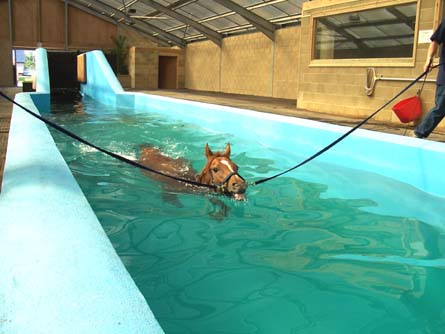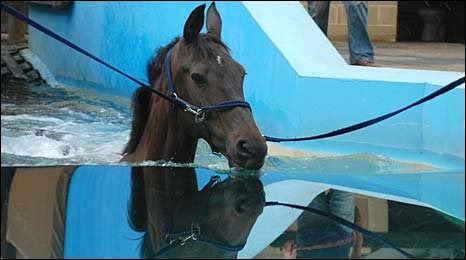
Swimming is often only considered when a horse sustains an injury and the vet rules out ridden exercise. In this situation, rehabilitation of the horse in an equine pool helps to maintain muscle tone, general fitness and mental health.
However, incorporating swimming into all your horses general training program will greatly assist in preventing injuries and improving performance. Historically the benefits of swimming have been poorly researched in many of the world’s leading racing nations in Europe, the US and Australia. This created a vacuum which has been filled by anecdotal evidence, based on personal experience, acquired by people swimming horses on a ‘trial and error’ basis.
Indeed, my own experience of swimming horses began in this way more than 30 years ago. Much of the advice I received in the early days from the pioneers of hydrotherapy laid the foundations for the methods I use today but to find out more I looked towards Japan.

Japan has a racing industry that other racing nations envy. Great prize money, happy owners and a fan-base that encompasses young and old alike. Trainers in Japan use hydrotherapy, particularly swimming, extensively and substantial research is carried out by Japanese vets.
In 2 yr old and late developing 3 yr old horses, the musculoskeletal stress which occurs as training progresses frequently results in loco motor diseases. This is believed to be due to the lack of fundamental strength of the horse as training intensifies.
As an example, one study carried out by Japanese vets conducted research over a 5 month period. The horses taking part, 50% male / female, were split into 3 groups.
All the horses were introduced to the pool and swam daily for 2 weeks preceding the trial.
Group 1 trained only on the track 6 days a week
Group 2 trained on the track 6 days a week and swam 4 days a week (300ma day throughout the 5 months)
Group 3 trained on the track 6 days a week and swam 4 days a week. Swimming was increased in line with track work intensity.
During the 5 month period the incidence of injuries which included tendinitis, shoulder lameness, pelvic injury and upper hind limb and forelimb fractures, were 62% in Group 1, 25% in Group 2 and 10% in Group 3.
Most of the injuries suffered by horses in Group 1 were chronic injuries, some career ending.
The highest level of significant improvement in aerobic capacity was in the horses in Group 3, followed by Group 2 and then Group 1.
The horses in Group 3 also had the highest level of general fitness.
Introducing swimming into the conventional training protocol for young horses can decrease vulnerability to injury, provide favorable results regarding training and is excellent for efficient improvement in performance capacity.
It is important to emphasis that introducing a horse to the pool and planning swimming regimes need to be done by a person who has had substantial experience of hydrotherapy to be beneficial. Every horse is different and the regime needs to be tailored on an individual case by case basis.

Here at Horse Homes we design and plan equestrian facilities including pools. When designing pools we provide a turnkey option which includes providing swimming regime protocols appropriate to the horses at the facility. Originally this service was only available to our construction clients but we have gradually been extending it to owners and trainers that already have access to a pool. If you would like to find out more please get in touch.
By: Liz Newman
Co-founder of www.horse-homes.com



